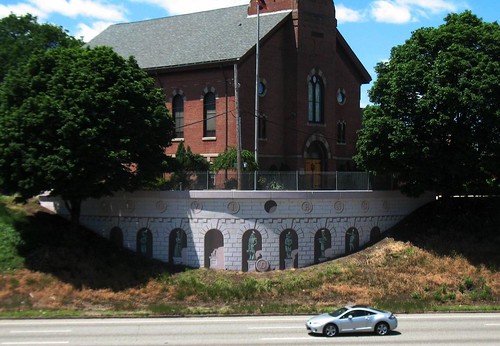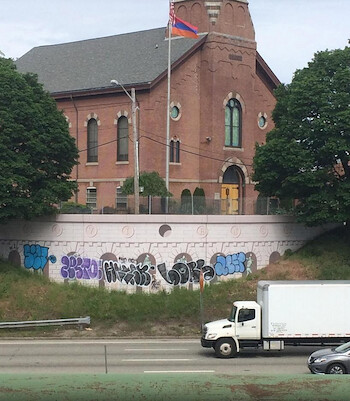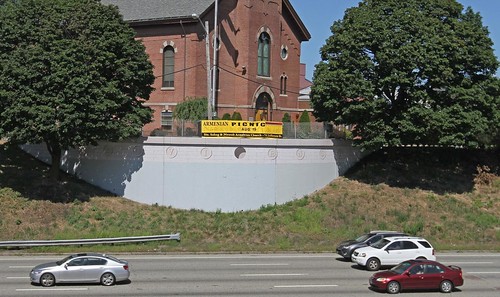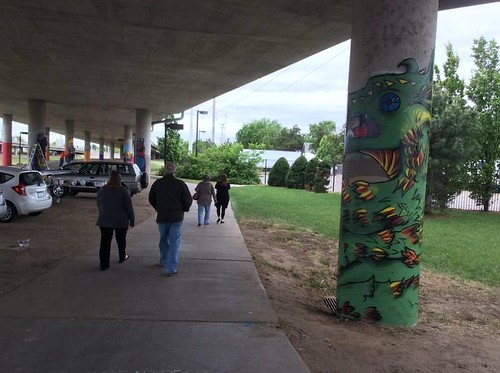There should be a "1% for placemaking" program associated with road projects (separate from incorporating sustainable mobility infrastructure)
 The wave pattern in the sidewalks of Biscayne Boulevard, Miami by Ricardo Burle Marx, is similar to what he did along Copacabana Beach in Brazil.
The wave pattern in the sidewalks of Biscayne Boulevard, Miami by Ricardo Burle Marx, is similar to what he did along Copacabana Beach in Brazil.Transportation architecture as civic architecture. The basic point is that it shouldn't be that hard to take the extra time and money to make transportation infrastructure simultaneous recognize its responsibility to function as civic architecture in a manner that enhances communities, rather than merely facilitate the movement of people and goods.
The most current discussion of the concept is developed in "Town-city management: we are all asset managers now."
In keeping with my various writings on "transportation infrastructure as an element of civic architecture," there used to be the "Transportation Enhancements" program funded by the US Highway Trust Fund. But that program was eliminated by the Republican Congress in the passage of the most recent transportation funding act.
An article in Public Roads magazine, "Making the Journey a Destination," discussed this program, which put aside funding for lots of good stuff:
- Provision of facilities for pedestrians and bicycles
- Provision of safety and educational activities for pedestrians and bicyclists
- Acquisition of scenic easements and scenic or historic sites (including historic battlefields)
- Scenic or historic highway programs (including the provision of tourist and welcome center facilities)
- Landscaping and other scenic beautification
- Historic preservation
- Rehabilitation and operation of historic transportation buildings, structures, or facilities (including historic railroad facilities and canals)
- Preservation of abandoned railway corridors (including the conversion and use of the corridors for pedestrian or bicycle trails)
- Inventory, control, and removal of outdoor advertising
- Archaeological planning and research
- Environmental mitigation to address water pollution due to highway runoff or reduce vehicle-caused wildlife mortality while maintaining habitat connectivity
- Establishment of transportation museum
Percent for art programs. During the Great Depression, the federal building program instituted a program that put one percent of the total budget for a project into "art and decoration."
Today, the federal building programs maintains this initiative as "Art in Architecture" at one-half of one percent of a project. Since the initial federal program, many cities and states have adopted similar programs.
Art funding for transportation projects. Many transit agencies have similar programs (Best Practices for Integrating Art into Capital Projects, booklet and report) American Public Transportation Association) and often public art--murals especially and sculpture--is incorporated into road, streetscape, and bridge projects. But it is more miss than hit when it comes to road projects.
Roadside Landscaping. Many jurisdictions provide some landscaping for beautification and vegetation management purposes, either at the city, county, or state scale.
The genesis for many of these programs was in the "parkway" approach to building long distance roads, although this way of building roads was supplanted by the creation of the Interstate Highway system ("Historic Roads in the National Park System," NPS). From the report:
The idea of parkways grew out of 19th century efforts to create beautify cities by creating grand, landscaped boulevards for the purpose of recreational pleasure afforded by walking, riding, driving carriages, and the social interaction that went along with it. Characteristics of these roads included limited-rights-of-way, careful plantings and landscape articulation, exclusion of commercial vehicles, and limited access. Often these boulevards were the approach roads to city parks, or connecting roads between them.Perhaps in response to the often grim freeway landscape, in 1965 Congress passed the Highway Beautification Act, spearheaded by Lady Bird Johnson ("How the Highway Beautification Act Became a Law," FHWA), although a primary element of that law had to do with billboards.
-- Benefits and Risks of Urban Roadside Landscape, NACTO
-- Use of native vegetation in roadside landscaping: a historical review
-- Synthesis of New Methods for Sustainable Roadside Landscapes
In Providence, Rhode Island, the State DOT doesn't have enough money to repaint a tagged mural. According to the Providence Journal ("‘I did my best’: David Macaulay saddened, but not surprised, by demise of R.I. highway mural"), an intricate mural based on the drawings of David Macauley and designed as a response to tagging was so damaged by a recent incident that they won't be replacing it, because they haven't maintained the program that first created the mural. From the article:
Macaulay’s whimsical vision depicted a row of arches with statues of famous Rhode Islanders, including Moses Brown and General Ambrose Burnside, several invented characters and a playful dog who appeared to have knocked down one of the statues while chasing a pigeon.That's a programmatic failure, and maybe a lack of money, but rather than be resigned to painting the graffiti over, why not address the need to provide operating funding to maintain murals and other placemaking elements of road projects?
But quite quickly, the Macaulay mural was tagged with graffiti — and then repaired — the year it was created under the initiative of then-Gov. Lincoln Chafee. The governor’s team had commissioned local artists and raised private donations to pay for several murals along major highways leading into the state. ...
Macaulay’s trompe l’oeil work in Providence was tagged again this winter, and then again in spring, state Department of Transportation spokesman Charles St. Martin explained Monday.
This time, the DOT couldn’t clean up the artwork as it did the last time.
Back then, the DOT still had under contract the agency whose muralists had painted Macaulay’s original design onto the curved wall near the highway, St. Martin said. This time, the graffiti was “pretty extensive over the entire structure,” St. Martin said, and the DOT no longer has a muralist on standby.



Why not create a "percent for placemaking" "highway" (transportation) program? Rather than just focus on public art, although "art" can be interpreted pretty expansively and includes street furnishings, pavement treatments, and other elements, "percent for art" programs should be repositioned as "percent for placemaking" programs, and systematically address treatments that include murals and sculptures, but go beyond it. Places that don't have such programs should be encouraged to create them.
Basically, eligible projects should include most of what had been part of the former transportation enhancements program, with the addition of public art elements.
 People walk Sunday on a bike path underneath Interstate 135 near freshly painted murals done by the group ICT Army of Artists. (May 1, 2016). Photo: Daniel Salazar The Wichita Eagle.
People walk Sunday on a bike path underneath Interstate 135 near freshly painted murals done by the group ICT Army of Artists. (May 1, 2016). Photo: Daniel Salazar The Wichita Eagle.But it should be done in a systematic fashion, especially with road projects, so elements treated as utilitarian elements like freeway abutments can be made more aesthetically attractive.
Include maintenance as a part of the program. The incident in Providence indicates that there should be funding set aside not just for creating placemaking elements but also for maintaining them. The way to do so would be to include funding for maintenance as part of "percent for placemaking" programs.
Labels: civic architecture, public realm framework, transportation infrastructure, transportation planning, urban design/placemaking





1 Comments:
Virginia DOT is doing a special treatment for freeway abutments in the Haymarket area.
https://www.washingtonpost.com/local/why-are-new-bridge-abutments-on-i-66-getting-a-special-paint-treatment/2017/08/09/2cc29568-7d16-11e7-83c7-5bd5460f0d7e_story.html
Post a Comment
<< Home